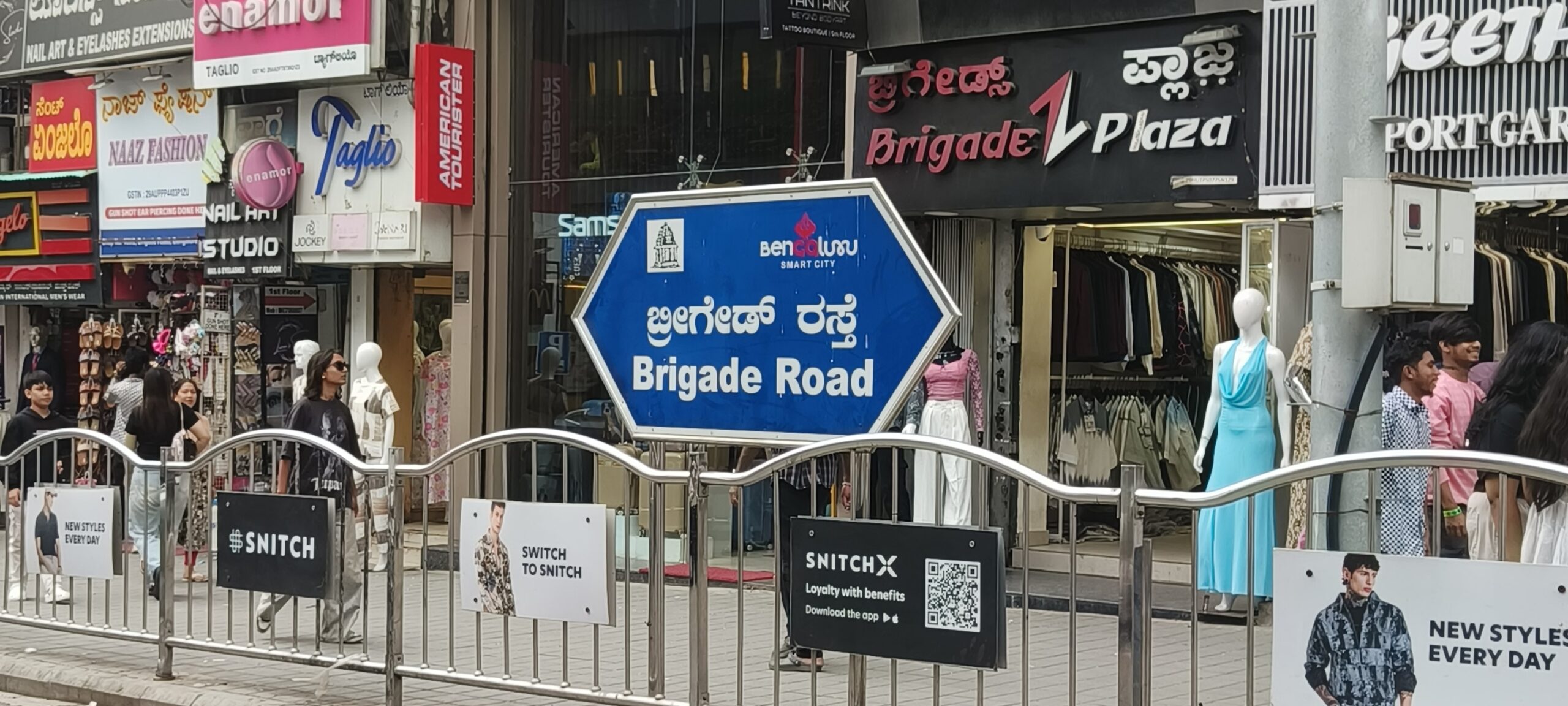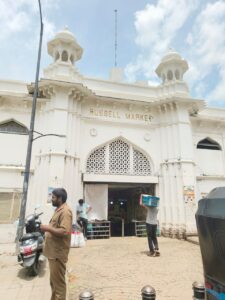The practice of naming streets after British officials was rooted in the desire to honour those in positions of administrative and military significance.
Published May 25, 2025 | 8:00 AM ⚊ Updated May 25, 2025 | 8:00 AM

Brigade Road, a bustling commercial area in the heart of the city, derived its name from the once military presence.
Synopsis: Some roads or places were rechristened after India gained Independence, but Bengalureans prefer the familiar names, not because of a colonial hangover or nostalgia, but for the sake of convenience.
Bengaluru, often celebrated as India’s Silicon Valley, is a city of speed, youth, and innovation. Yet, beneath the glass facades of co-working spaces and buzzing cafes, lie traces of a different legacy, one that dates back to British rule.
The names of some of the city’s busiest streets, most visited parks, and oldest markets still reflect a colonial presence that, for the most part, goes unquestioned and unnoticed.
From Fraser Town to Infantry Road, Cunningham Road to Richmond Road, the streets of Bengaluru honour British officials, army divisions, and administrative functionaries who once defined the power structures of the region. While official attempts have been made to rename some of these places post-independence, public memory and popular usage remain deeply tied to their colonial identity.

Russell Market, built in 1927 and inaugurated in 1933, was named after TB Russell, the then-Municipal Commissioner.
Much of this naming pattern can be traced back to the Cantonment area, developed in the early 19th century to serve the needs of the British military. Unlike the older Pete area built by the Mysore rulers, the Cantonment represented the colonial vision of urban planning of wide roads, European architecture, military barracks, churches, and clubs.
In these spaces, names became a tool of power and memory, celebrating not local heroes but British figures of importance.
Architect and urban planner Naresh V Narasimhan, Managing Partner at Venkataramanan Associates, explained that the practice of naming streets after British officials was rooted in the desire to honour those in positions of administrative and military significance.
“Most of these roads were named after British officials, commissioners, tutors to the Maharajas, and military officers,” he said. “Some were named after army divisions stationed here, like Infantry Road and Brigade Road.”
For instance, Fraser Town was named after Stuart Fraser, tutor to the Yuvaraja of Mysore. Cunningham Road commemorates Francis Cunningham, a key figure in the Mysore Commission. Richmond Road traces its name to Colonel Richmond, while Cubbon Road and Cubbon Park are attributed to Sir Mark Cubbon, who served as British Commissioner of Mysore from 1834 to 1861.

Church Street, a bustling street in Central Business District, leads to the St Mark’s Cathedral.
Each of these individuals played a role directly in shaping the colonial administration, and their names became fixed in the city’s urban map.
Incidentally, most people, including long-time residents, are unaware of the original or alternative names of places or roads in the city.
Not many knew that MG Road was once called South Parade, or that Cubbon Park has long been officially renamed Sri Chamarajendra Park. Several tourists, while vaguely familiar with older names through guidebooks or Google Maps, admitted they found them hard to pronounce and rarely used them in conversation.
“I came across another name for this road, but it’s easier to go with the commonly used one, like MG Road or Church Street,” said one tourist.
The locals have grown up with these names and never questioned their origins or alternatives. For them, Russell Market is Russell Market, and Brigade Road is Brigade Road. The names were part of the city’s spoken style, convenient, unchanging, and familiar.
When asked about the persistence of these names, Narasimhan highlighted that it is the usage and continuity rather than nostalgia.
“It’s not necessarily nostalgia,” he said. “These names have been in circulation for more than 150 years. They are embedded in the public consciousness.”
Indeed, the highlight of the colonial names in Indian cities is not unique to Bengaluru. However, Bengaluru’s case is particularly layered; the names not only remain but thrive in everyday talk, city marks, and even branding.
There have been official attempts to change the names. For instance, MG Road (Mahatma Gandhi Road) replaced South Parade in the early years after independence. Cubbon Park, in 1927, was officially renamed after Sri Chamarajendra Wodeyar, the then Maharaja of Mysore.
However, these changes, though recorded in government documents, have not been adopted by the general public.
The colonial names are reinforced through maps, businesses, and popular usage. So, should these names be changed? Is their presence an endorsement of colonial history?
Narasimhan offered a thoughtful approach: “There are a lot of new roads in Bengaluru which can be named after new people. These names are also part of our history. The British presence in India was exploitative, yes, but people have gotten used to these names. Instead of calling something 100 Feet Road or Outer Ring Road, we can use those spaces to honour modern Indian personalities who have contributed to the city.”
This view resonated with a broader unity among urban historians and planners that historical memory must be expanded, not erased. The colonial names need not be removed but can be supplemented with plaques, QR codes, or digital archives explaining their origin and offering context about who these figures were and what their roles meant during the British Raj.
Bengaluru’s colonial roads are more than routes of travel; they are signposts of history, woven into the city’s urban fabric. But as the city grows and redefines itself in the 21st century, there is a need for interchange between past and present, between the names we inherit and the names we choose.
By reclaiming public memory and engaging with the stories behind these spaces, Bengaluru has the opportunity to honour its complex history while carving space for new voices and new names that reflect a more inclusive and locally grounded vision of the city.
(Edited by Majnu Babu).
